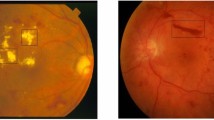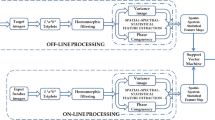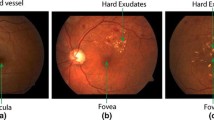Abstract
Heretofore schemes highly rely on complex feature characterization modules assisting the detection and classification of Diabetic Macular Edema (DME). DME encompasses intrinsic local variations that need to be analyzed for treatment. Accordingly, this paper delivers a localized fundus image feature characterization scheme supporting acute abnormality detection and classification of diverse DME abnormalities. This is accomplished by deploying the localized Triangulated Feature Descriptor (TFD) that solely operates on fundus images to capture appropriate features that are deemed essential for DME detection and classification. TFD is operated in three modes for extracting the vital features and is then coupled with simple image representation schemes to deliver precise feature descriptors concerned with diverse abnormalities. The resultant features are then classified by a supervised learning machine for grading the diverse DME ailments. The novel mechanism is elaborately investigated on benchmarked databases namely DRIVE, DIARETDB1, and MESSIDOR using Receiver Operating Characteristics parameters. The assessments reveal the superiority of the proposed approach over its counterparts. Also, the minimal computational operations involved in capitulating the essential image characteristics is another quality that makes this scheme amicable for real-time DR diagnosis.








Similar content being viewed by others
Data Availability
Three publicly available datasets namely DRIVE, DIARETDB1 and MESSIDOR are utilized for performance analysis of the presented methodology.
Code Availability
The code developed towards the realization of the framework discussed in the paper forms a part of the author’s research work and hence unavailable.
References
Vision Problems in the U.S. Prevalence of Age-Related Eye Disease in America. Available: http://www.visionproblemsus.org/index.html
Grading Diabetic Retinopathy from Stereoscopic Color Fundus Photographs—An Extension of the Modified Airlie House Classification. Ophthalmology, 98 (5): 786–806, May, 1991.
Mookiah, M. R. K., Acharya, U. R., Fujita, H., Tan, J. H., Chua, C. K., Bhandary, S. V., Laude, A., & Tong, L. (2015). Application of different imaging modalities for diagnosis of diabetic macular edema: A review. Computers in Biology and Medicine, 66, 295–315.
Mookiah, M. R. K., Acharya, U. R., Chua, C. K., Lim, C. M., Ng, E., & Laude, A. (2013). Computer-aided diagnosis of diabetic retinopathy: A review. Computers in Biology and Medicine, 43, 2136–2155.
Treatment techniques and clinical guidelines for photocoagulation of diabetic macular edema: Early treatment diabetic retinopathy study report number 2, Early Treatment Diabetic Retinopathy Study Research Group. Ophthalmology, 94 (7): 761–774 (1987).
International Diabetes Federation and The Fred Hollows Foundation. Diabetes eye health: A guide for health care professionals. Brussels, Belgium: International Diabetes Federation, 2015. www.idf.org/eyecare
Jahne, B., Haubecker, H., & Geibler, P. (1999). Handbook of computer vision and applications: Signal processing and pattern recognition (Vol. 2). Academic Press.
Priyanka, S., & Sudhakar, M. S. (2018). Tetrakis square tiling-based triangulated feature descriptor aiding shape retrieval. Digital Signal Processing, 79, 125–135.
Nayak, J., Bhat, P. S., & Acharya, U. R. (2009). Automatic identification of diabetic maculopathy stages using fundus images. Journal of Medical Engineering and Technology, 33(2), 119–129.
Punnolil, A. A novel approach for diagnosis and severity grading of diabetic maculopathy. International conference on advances in computing, communications and informatics (ICACCI) IEEE: no.978–1–4673–6217–7/13, 1230–1235.
Tariq, A., Akram, M. U., Shaukat, A., & Khan, S. A. (2013). Automated detection and grading of diabetic maculopathy in digital retinal images. Journal of Digital Imaging, 26(4), 803–812.
Haloi, M., Dandapat, S., & Sinha, R. (2015). A Gaussian scale space approach for exudates detection, classification and severity prediction. Preprint https://arxiv.org/abs/1505.00737
Sisodia, D. S., Nair, S., & Khobragade, P. (2017). Diabetic retinal fundus images: Preprocessing and feature extraction for early detection of diabetic retinopathy. Biomedical and Pharmacollogy Journal, 10(2), 615–626.
Yavuz, Z., & Köse, C. (2017). Blood vessel extraction in color retinal fundus images with enhancement filtering and unsupervised classification. Journal of Healthcare Engineering. https://doi.org/10.1155/2017/4897258
Jonas, R. A., Wang, Y. X., Yang, H., Li, J. J., Xu, L., & Panda-Jonas, S. (2015). Optic Disc-Fovea Distance, axial length and parapapillary zones The Beijing Eye Study 2011. PLoS ONE. https://doi.org/10.1371/journal.pone.0138701
Saha, S. K., Fernando, B., Xiao, D., Tay-Kearney, M. L., & Kanagasingam, Y. (2016). Deep learning for automatic detection and classification of microaneurysms, hard and soft exudates, and hemorrhages for diabetic retinopathy diagnosis. Investigative Ophthalmology and Visual Science, 57(12), 5962–5962.
Van Grinsven, M. J. J. P., Venhuizen, F., Van Ginneken, B., Hoyng, C. C. B., Theelen, T., & Sanchez, C. I. (2016). Automatic detection of hemorrhages on color fundus images using deep learning. Investigative Ophthalmology and Visual Science, 57(12), 5966–5966.
Tan, J. H., Fujita, H., Sivaprasad, S., Bhandary, S. V., Rao, A. K., Chua, K. C., & Acharya, U. R. (2017). Automated segmentation of exudates, haemorrhages, microaneurysms using single convolutional neural network. Information Sciences, 420, 66–76.
Al-Bander, B., Waleed, A-T., Majid, A., Bryan, M., & Zheng, Y. (2017). Diabetic macular edema grading based on deep neural networks. In Proceedings of the Ophthalmic medical image analysis third international workshop, OMIA 2016 (pp. 121–128), Athens, Greece.
Guo, X., Lu, X., Zhang, B., Hu, X., & Che, S. (2022). Automatic detection and grading of diabetic macular edema based on a deep neural network. Retina. https://doi.org/10.1097/IAE.0000000000003434
Bressler, I., Aviv, R., Margalit, D., Ianchulev, S., & Dvey-Aharon, Z. (2022). Autonomous screening for Diabetic Macular Edema using deep learning processing of retinal images, Medrxiv. Preprint at https://www.medrxiv.org/content/https://doi.org/10.1101/2022.08.07.22278511v1.full
Date, R. C., Shen, K. L., Shah, B. M., Sigalos-Rivera, M. A., Chu, Y. I., & Weng, C. Y. (2019). Accuracy of detection and grading of diabetic retinopathy and diabetic macular edema using teleretinal screening. Ophthalmology Retina, 3(4), 343–349.
Guo, S., Wang, K., Kang, H., Liu, T., Gao, Y., & Li, T. (2020). Bin loss for hard exudates segmentation in fundus images. Neurocomputing, 392, 314–324.
Satyananda, V., & Narayanaswamy, K. V. (2020). Detection of exudates from fundus images (Vol. 1). Springer.
Singh, R. K., Gorantla, R., & Pławiak, P. (2020). DMENet: Diabetic macular edema diagnosis using hierarchical ensemble of CNNs. PLoS ONE. https://doi.org/10.1371/journal.pone.0220677
Gonzalez, R. C., & Woods, R. E. Digital Image Processing, Pearson Education, Inc. 2007; ISBN 10:013168728X: 122–827.
MESSIDOR Database: http://messidor.crihan.fr/index-en.php
DIARETDB1- https://www.it.lut.fi/project/imageret/
Syed, A. M., Akram, M. U., Akram, T., Muzammal, M., Khalid, S., & Khan, M. A. (2019). Fundus images-based detection and grading of macular edema using robust macula localization. IEEE Access., 6, 58784–58793.
Hajian-Tilaki, K. (2013). Receiver operating characteristic (ROC) Curve analysis for medical diagnostic test evaluation. Caspian Journal of Internal Medicine, 4(2), 627–635.
Sopharak, A., Uyyanonvara, B., Barman, S., & Williamson, T. H. (2008). Automatic detection of diabetic retinopathy exudates from non-dilated retinal images using mathematical morphology methods. Computerized Medical Imaging Graphics, 32(8), 720–727.
Osareh, A., Shadgar, B., & Markham, R. (2009). A computational-intelligence based approach for detection of exudates in diabetic retinopathy images. IEEE Transactions on Information Technology in Biomedicine, 13(4), 535–545.
Reza, A. W., & Eswaran, C. (2011). A decision support system for automatic screening of non-proliferative diabetic retinopathy. Journal of Medical Systems, 35(1), 17–24.
García, M., Sánchez, C. I., López, M. I., Abásolo, D., & Hornero, R. (2009). Neural network based detection of hard exudates in retinal images. Computer Methods and Programs in Biomedicine, 93(1), 9–19.
Ranamuka, N. G., & Meegama, R. G. N. (2013). Detection of hard exudates from diabetic retinopathy images using fuzzy logic. IET Image Process., 7(2), 121–130.
Jaafar, H. F., Nandi, A. K., & Al-Nuaimy, W. (2011). Decision support system for the detection and grading of hard exudates from color fundus photographs. Journal of Biomedial Optics, 16(11), 116001.
Deepak, K. S., Medathati, N. V. K., & Sivaswamy, J. (2012). Detection and discrimination of disease-related abnormalities based on learning normal cases. Pattern Recognit., 45(10), 3707–3716.
Al-Bander, B., Al-Nuaimy, W., Al-Taee, M. A., Williams, B. M., & Zheng, Y. (2016). Diabetic macular edema grading based on deep neural networks, University of Iowa.
Li, X., Hu, X., Yu, L., Zhu, L., Fu, C. W., & Heng, P. A. (2020). CANet: Cross-disease attention network for joint diabetic retinopathy and diabetic macular edema grading. IEEE Transactions on Medical Imaging, 39(5), 1483–1493. https://doi.org/10.1109/TMI.2019.2951844
Funding
This manuscript is a part of the research work executed by the author towards the Doctoral degree. Hence, no grants / funding were received for this work.
Author information
Authors and Affiliations
Contributions
All authors contributed to the study conception and design. Material preparation, data collection and analysis were performed by KRR, MNG and MSS. The first draft of the manuscript was written by KER. and all authors commented on previous versions of the manuscript. All authors read and approved the final manuscript.
Corresponding author
Ethics declarations
Conflict of interest
The authors declare that they have no known competing financial interests or personal relationships that could have appeared to influence the work reported in this paper.
Ethics Approval
The data utilized in this research is publicly available and downloaded from relevant websites.
Consent to Participate
The authors wish to participate in surveys that align with the areas of the submitted manuscript when the journal conducts the same.
Consent for Publication
The authors agree to the norms prescribed by the journal to proceed with the publication process post the peer-review.
Additional information
Publisher's Note
Springer Nature remains neutral with regard to jurisdictional claims in published maps and institutional affiliations.
Rights and permissions
Springer Nature or its licensor (e.g. a society or other partner) holds exclusive rights to this article under a publishing agreement with the author(s) or other rightsholder(s); author self-archiving of the accepted manuscript version of this article is solely governed by the terms of such publishing agreement and applicable law.
About this article
Cite this article
Remya, K.R., Giriprasad, M.N. & Sudhakar, M.S. A Localized Feature Description Means Assisting Diabetic Macular Edema Detection and Classification. Wireless Pers Commun 129, 2909–2927 (2023). https://doi.org/10.1007/s11277-023-10264-z
Accepted:
Published:
Issue Date:
DOI: https://doi.org/10.1007/s11277-023-10264-z




